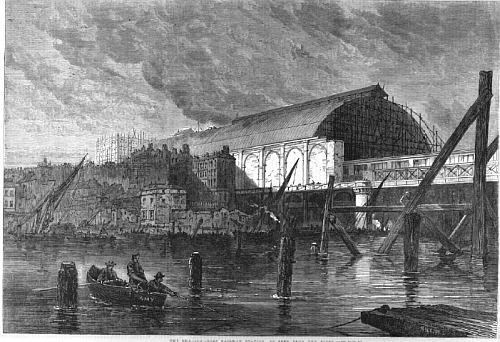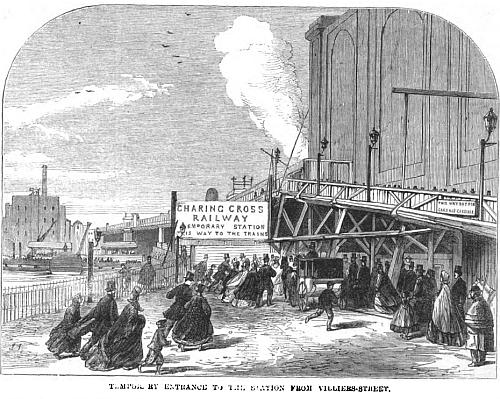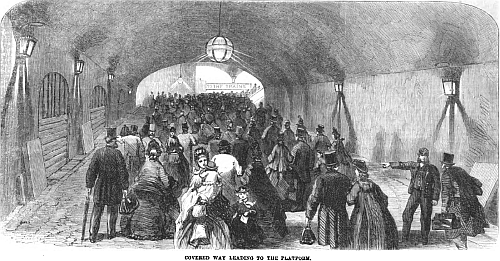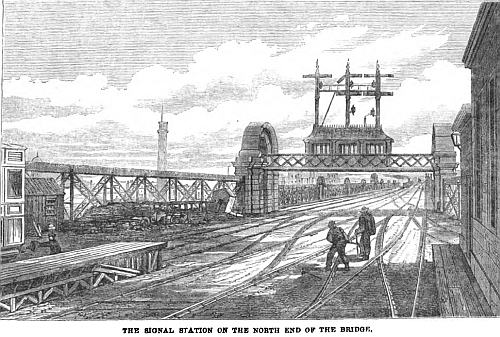

Search london history from Roman times to modern day
The New Hungerford Market was built in 1830 and replaced by Charing Cross station by 1864. And now in March 2020.

Charing Cross Station in 1864, as viewed from the river
Charing Cross Station
London is gradually but rapidly undergoing such a complete metamorphosis that in
the space of a few years it will be difficult to trace out even its best-known
sites or most prominent features. The traveller who, after ten years' sojourn in
other lands, shall retrace his steps to London will be scarcely able to make out
portions of it once the most familiar to his eye, and will be disposed to say of
town, in language similar to that in which Bottom's companions addressed him,
though it is to be not so depreciatingly
“Oh, London thou art transformed !”
The bridges over the Thames are, of course, among the most prominent and
noticeable features of our metropolis. These are to be, or have been recently,
nearly all rebuilt, and many new ones erected and in progress. The great
thoroughfares of town remain, but the houses in them are rapidly changing in
appearance. Many of the second and third rate streets have been altered;
thousands of the poorer habitations have been swept away, and many new streets
have been opened up to the public. The transformation is still going on; new
railway and other companies threaten us on every side; the Thames Embankment
will of itself make a wonderful change in the appearance of London; and our only
fear is that we shall be “improved” off the face of the earth, so many are the
schemes for our benefit. Our position in this respect has at length attracted
the attention of Parliament, which seems now to have determined against the
attacks of our numerous besieging engineers. If the Parliamentary Committee to
be appointed to inquire into the various plans will only see to confining each
effort within proper bounds, and to protecting us from conflicting schemes, we
have much to be thankful for.
In no part of London has a greater improvement been made than upon the spot
where Hungerford Market once stood. Not a vestige of the various structures now
remain. The fishmongers who once carried on business in this West-end
Billingsgate have all dispersed to settle down here and there in various places
in and about the Strand. As if by a wave of an enchanter's wand the elegant
Hungerford suspension bridge which once graced our river has been removed 120
miles away — to Clifton, and a new and more solid bridge erected in its stead.
The Hungerford Music hall is among the things of the past; every approach to
what was once the market, and to the riverside between Villiers street and
Craven street, has been altered, and the site is occupied by an immense railway
station—the West-end terminus of the Charing-cross Railway. This station is not
quite finished, so we will not now enter into a minute description of it.
Suffice it here to say, that it stands about 100 ft. from the Strand roadway,
that it has about 200 ft. width of frontage, and that its ground floor will be
set apart for booking-offices, refreshment rooms, &c., and all its upper stories
will be used for hotel purposes. In the open space between the roadway and this
station carriages will deposit passengers after passing through the lodge gates
at the entrance, and in its centre will be erected— not far from the spot where
the original memorial stood— a facsimile of the ancient Eleanor Cross which once
adorned the village of Charing, and gave the name to the neighbourhood which it
to this day retains. The arrangements of the Charing-cross Railway Company,
incomplete as they are at present, are yet sufficiently advanced to provide for
a large amount of public traffic, and we have thought it advisable to show, by
some Illustrations, the extent of the accommodation. Turning from the Strand
down Villiers street, we at once perceive a great alteration. Dingy dwellings
have been cleared away, the new railway station's massive side shows in lofty
pre-eminence on our right hand, and bright, business-like : and
refreshment-rooms on the opposite side of the way. Lower down, we come upon a
turnstile whereat foot passengers wishing to cross the river pay the usual
halfpenny toll and then walk on. Footways, we find, of about 7ft. in width have
been made for their convenience upon each side of the railway bridge. At the
bottom of Villiers-street is a communication by means of which steam-boat
passengers use the Hungerford landing-pier. From that pier we have a near view
of the new Charing Cross Railway Station.
This magnificent structure, with a semicircular roof of iron and glass, far
exceeds in span the much-admired roofs of the Great Northern Railway at
King's-cross, which are only 105ft, while these are nearly 200ft. The passenger
platforms at present in use project beyond the limits of this glass roof upon a
part of the bridge, which widens out from the ordinary breadth of four lines of
rail into a fanlike form, containing seven lines.
In February, 1860, the entire railway works were begun, and when we look upon
the vast extent of labour here accomplished, we must admit that the time has
been well occupied. The contract was enormously heavy, considering the short
distance of the line-scarcely two miles—for in its brief limits are comprised
seventeen bridges; 190 brick arches, of which eighteen are over streets; an iron
viaduct of 404ft. over the Borough Market; the Charing-cross station, the iron
in whose roof weighs over 1200 tons; and the Charing cross railway-bridge,
containing 5000 tons of wrought and 2000 tons of cast iron. At present trains
run from Charing-cross every quarter of an hour, beginning at ten minutes past
seven in the morning, up to twenty-five minutes past twelve at night; and there
are 140 journeys made daily to and from Greenwich, and thirty-four on the Mid
Kent line. On the 1st of March the line, it is expected, will be open for North
Kent traffic; and upon the 1st of May will be in working order throughout for
South-Eastern and Continental business. On latter date the cabmen attached to
the station will all appear in uniform.
The temporary entrance to the station will hereafter serve only for empty cabs,
which will by this way pass the arrival-platform, on the western side. near
where the Custom-house officials will be in readiness to examine luggage brought
by the Continental trains. The cab-rank is now stationed beneath the first
archway seen after entering the temporary inclosure. Passing by the rank, and
under a shed to protect from the weather, we now enter the tunnel-like roadway
used for passengers, which we have named, perhaps too untechnically, The Tunnel
Entrance.

Charing Cross Station in 1864, temporary entrance from Villiers styreet
This passage, pitched with rough stones for horse traffic, is not pleasant for
tender feet to traverse; but we are obliged to accept the excuse that it is only
to be used by foot passengers for a short time as sufficient explanation. Its
length, great as it appears to be at first sight, is not so extensive as the
width of the station above, for beyond are offices for the porters and other
servants of the company.

Charing Cross Station in 1864, covered way leading to the platform
The Signal Station, next to Charing-cross, is remarkable for the ingenious
character of its arrangements. By the use of one of Saxby and Farmer's patent
signalling instruments, one man is enabled to conduct the whole of the numerous
trains in and out of the station without difficulty; whereas, by the
old-fashioned plan at least half a dozen men at a time would have been required,
and even they could not have succeeded so well in discharging the duties of this
very onerous post. Of course the labour cannot now be performed without
considerable care; there are, therefore, three signalmen employed at this one
station, who have to relieve each other in turn. Posted in a glass room right
over the lines, and commanding a full view both up and down, the signalman is
enabled not only to communicate with the next signal-box, but to manage the
switches which lie at least 100 yards off. When a train is about to leave the
station it whistles twice, to signify “ready to go;" whereupon, if all be well,
the signalman adjusts the signal and, if necessary, operates on the switches.
The signals at the other end of the bridge (from the signal-box they call the
Belvidere) show all to be right, and away the train goes, to be signalled from
station to station in the same way—namely, from Charing-cross to Belvidere, from
Belvidere to Waterloo Junction, from Waterloo Junction to Blackfriars, and from
Blackfriars to London Bridge. The amount of vibration felt upon the new
Charing-cross Bridge as the heavy trains pass over it is very slight, scarcely
more than upon solid ground, and the bridge is reckoned to be one of the
strongest ever built. Well it might be, since it has to sustain an amount of
wear and tear which would soon tell upon an insecure structure. The trains which
are to run down the South-Eastern lines and the North and Mid Kent lines will be
supplemented, in a year or so, by another series, in itself requiring an
every-five-minute traffic. The new line we refer to will be that to
Cannon-street, for which, at present, there is only a single line of rails
provided. A n may now go from Charing cross to Blackfriars, by means of the new
railway, in three minutes; to London Bridge in ten minutes: to Spa-road in
fourteen minutes; to Deptford in twenty-one minutes; and to Greenwich in
twenty-five minutes. All the trains have first, second, and third class
carriages, and the fares are some of them very low, though, perhaps, not yet so
small as they may hereafter be made. From Charing-cross to London Bridge, by
third class, a person may go for 3d, ; and he may be carried to and fro for 1d,
more. The fare to Greenwich is only 6d.

Charing Cross Signal Station in 1864, on the north end of the bridge
Trying to avoid privacy and cookie settings overwriting content